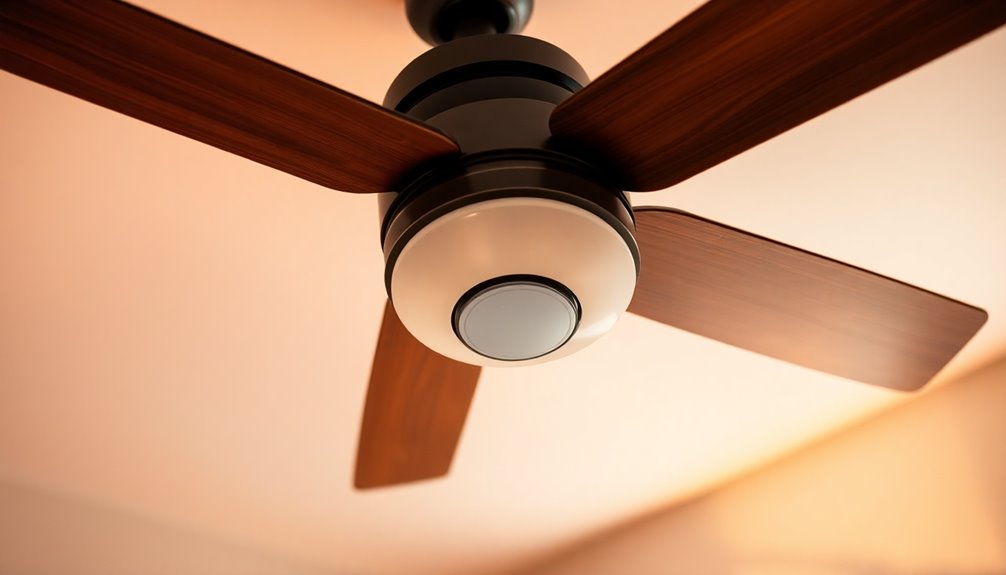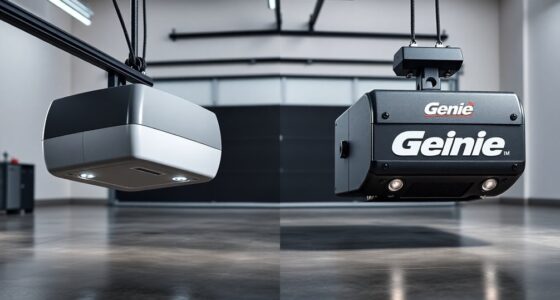The reverse function on your ceiling fan is essential for enhancing comfort and energy efficiency throughout the year. In summer, a counterclockwise rotation pushes cool air down, creating a invigorating breeze. In winter, switch to clockwise to pull warm air up, redistributing heat and saving on heating costs. This simple adjustment can help you maintain consistent indoor temperatures and manage humidity levels effectively. By maximizing airflow, you can boost your energy savings and enjoy a more pleasant environment. Stick around, and you'll discover even more cool facts about how to get the most from your ceiling fan.
Key Takeaways
- The reverse function on a ceiling fan allows for clockwise rotation in winter, pulling warm air up and redistributing it throughout the room.
- By mixing warm air with cooler air below, the reverse setting ensures consistent indoor temperatures and reduces cold spots.
- Using the reverse function can save up to 10% on heating costs during winter months, enhancing energy efficiency.
- Ceiling fans with reverse capabilities can work alongside heating systems, extending their lifespan and reducing energy consumption.
- Adjusting fan direction seasonally contributes to improved comfort and effective humidity control year-round.
Even Air Distribution

When you adjust your ceiling fan's direction, you're not just changing airflow; you're enhancing even air distribution throughout your space.
By using the directional switch on your fan, you can easily toggle between counterclockwise and clockwise rotation. In summer, the blades spin counterclockwise, pushing cool air down and creating a revitalizing breeze.
In winter, switching to clockwise pulls warm air upwards, redistributing it back into your room. This simple adjustment helps maintain consistent temperatures, preventing cold spots and enhancing comfort. Proper direction not only improves air circulation but also increases energy efficiency, leading to lower utility bills.
Plus, it allows for better air circulation throughout the area, making your home feel cozier.
Energy Efficiency Benefits
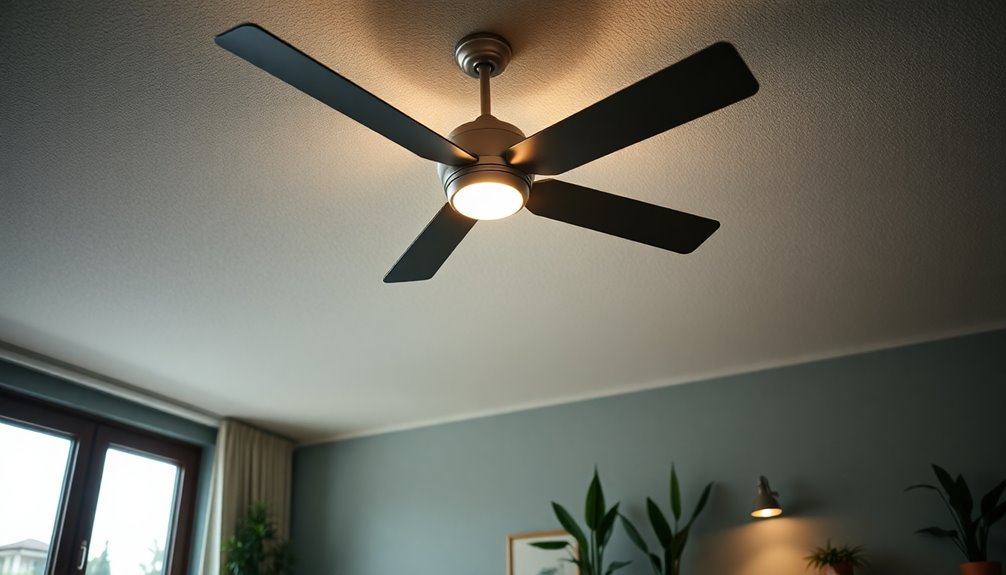
Utilizing your ceiling fan efficiently not only enhances comfort but also offers significant energy savings.
By reversing the fan's direction in winter, you can redistribute warm air trapped near the ceiling, ensuring it reaches every corner of the room. This helps your thermostat sense the warmth and shut off the furnace sooner, potentially saving you up to 10% on heating costs. Additionally, running your ceiling fan in conjunction with a heat pump can lead to even greater energy savings by optimizing heat distribution throughout the space.
Ceiling fans consume far less energy than heating systems, making them an efficient choice. Plus, consistent circulation reduces strain on your furnace, extending its lifespan. In addition, running ceiling fans in winter can lead to improved overall energy efficiency, further contributing to lower utility bills.
Humidity Control Mechanisms
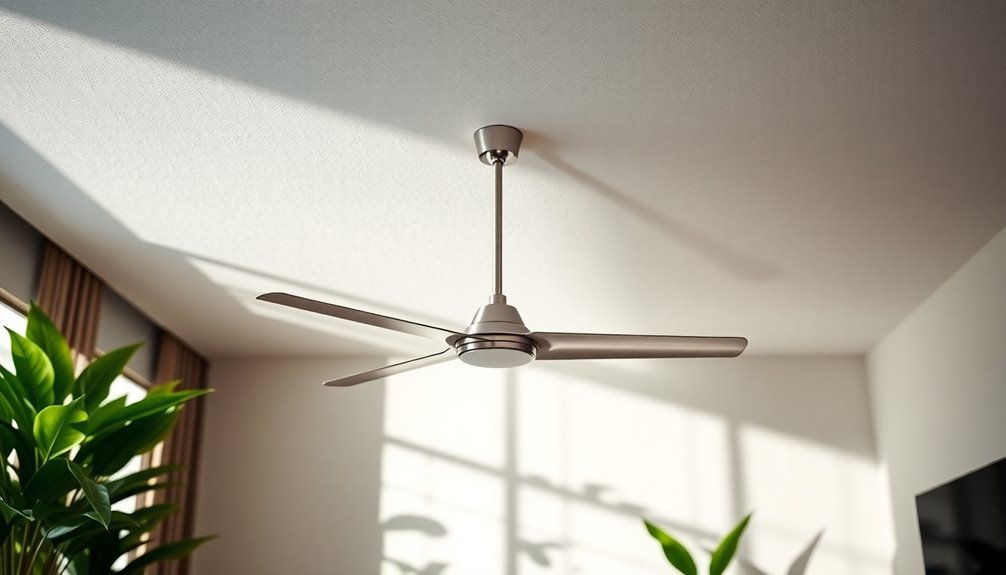
Humidity control mechanisms are essential for maintaining a comfortable indoor environment, especially in areas prone to excess moisture.
Devices like the Leviton Humidity Sensor can automatically detect excess humidity and activate the ventilation fan to reduce condensation. You can adjust the sensor's sensitivity to avoid false triggers and set customizable timers for operation, ensuring the fan runs only when needed. Additionally, this device includes a pushbutton control for immediate relief, allowing you to activate the fan at a moment's notice. The humidistat mode offers further flexibility, managing fan operation based on specific humidity levels.
These mechanisms not only provide effective humidity control but also help reduce energy usage, keeping your energy bills in check while maintaining a dry and comfortable space.
Comfort in Rainy Seasons
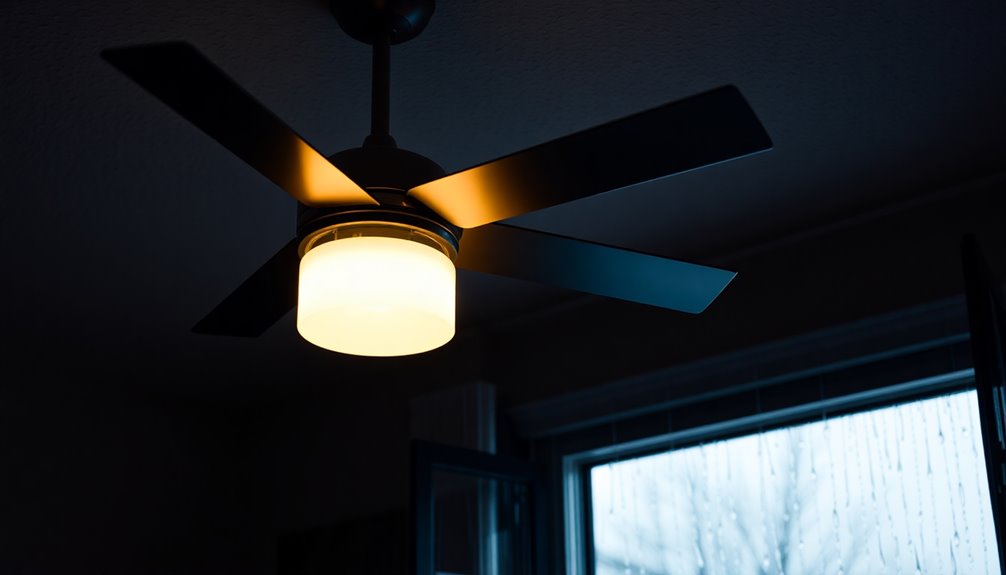
As rainy seasons bring increased humidity and cooler temperatures, maintaining comfort indoors becomes essential.
Using the reverse function on your ceiling fan can help mix the warmer air near the ceiling with the cooler air below. This guarantees a consistent indoor temperature, reducing discomfort from uneven air distribution. Improved air circulation promotes better ventilation, making your space feel less stuffy and more enjoyable. Additionally, it helps manage humidity levels, creating a more comfortable environment. By optimizing air movement, your ceiling fan enhances indoor comfort and supports your air conditioner's efficiency, potentially lowering electricity bills. Furthermore, the reverse function can lead to significant energy savings when used strategically, contributing to lower overall electricity costs.
Operating in Winter
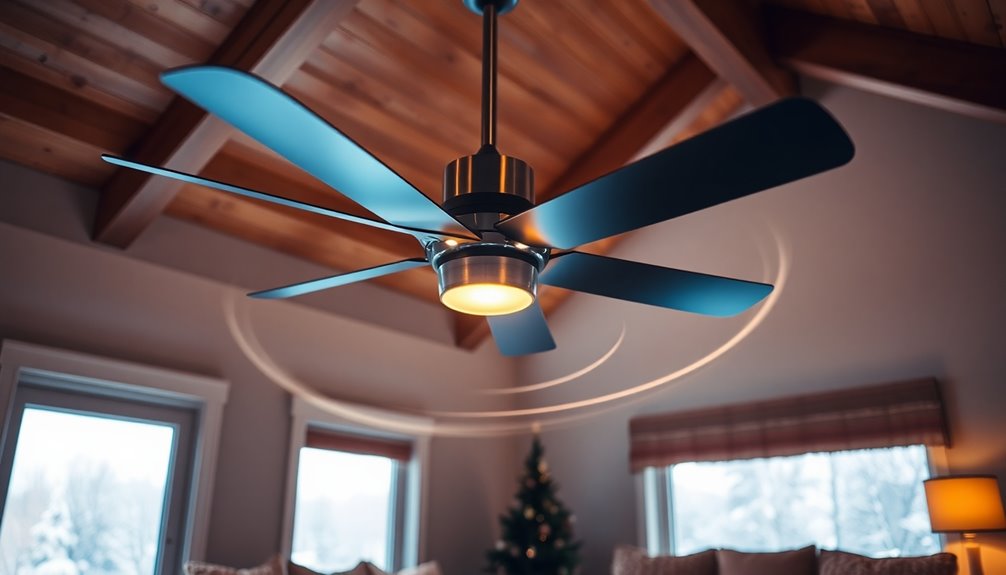
When winter rolls in and temperatures drop, you can make your home cozier by using the reverse function on your ceiling fan.
Warm air naturally rises, leaving colder air near the floor. By reversing your fan's direction, you push that warm air down, creating a gentle updraft that redistributes heat evenly throughout the room. This not only keeps your space more comfortable but can also save you up to 10% on heating costs. Additionally, maintaining a consistent temperature distribution helps eliminate cold spots near the floor.
Running your fan at a low speed guarantees a draft-free experience, enhancing comfort without the chill.
Operating in Summer

Using your ceiling fan in summer can greatly enhance comfort while keeping energy costs in check.
To maximize cooling, make sure your fan spins counterclockwise. This creates a downdraft that delivers a revitalizing breeze, speeding up moisture evaporation on your skin and making you feel cooler. You can even raise your thermostat a few degrees without sacrificing comfort. Additionally, adjusting your fan for seasonal efficiency can lead to increased energy savings throughout the summer.
Running your ceiling fan can save you up to $38 a month in cooling costs by reducing the load on your air conditioner. Regularly check the direction of your fan blades, and keep them clean for peak performance.
With the right adjustments, your ceiling fan becomes a powerful ally against summer heat, enhancing your indoor comfort efficiently.
Adjusting Your Ceiling Fan
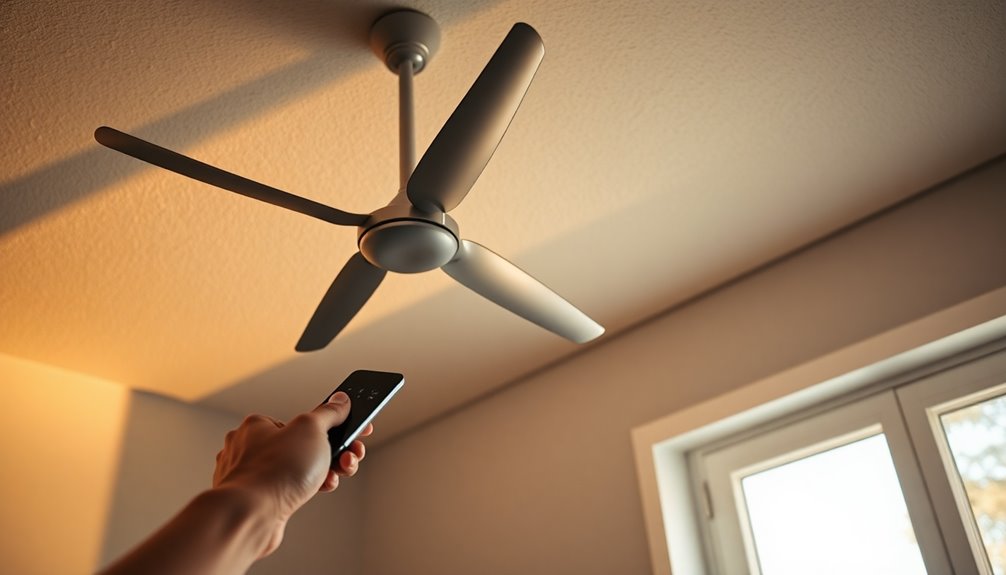
Adjusting your ceiling fan is essential for optimizing comfort and energy efficiency throughout the year.
By using the reverse function, you can enhance air distribution, ensuring cool air from your air conditioner circulates evenly, especially in hot, humid climates. This improved ventilation helps manage indoor humidity levels, making your space feel less stuffy. Additionally, ceiling fan blades rotating clockwise in winter helps to circulate warm air accumulated on ceilings, promoting thermal comfort. Regular maintenance of the fan can further ensure it operates efficiently throughout the seasons.
During monsoon seasons, mixing warmer air near the ceiling with cooler air below keeps your indoor environment comfortable.
Additionally, when paired with your heating system in winter, the fan reduces the furnace's workload, lowering energy consumption and electricity bills.
With modern fans featuring remote controls, adjusting the fan direction is easy, ensuring you get the most out of your ceiling fan year-round.
Understanding Fan Rotation
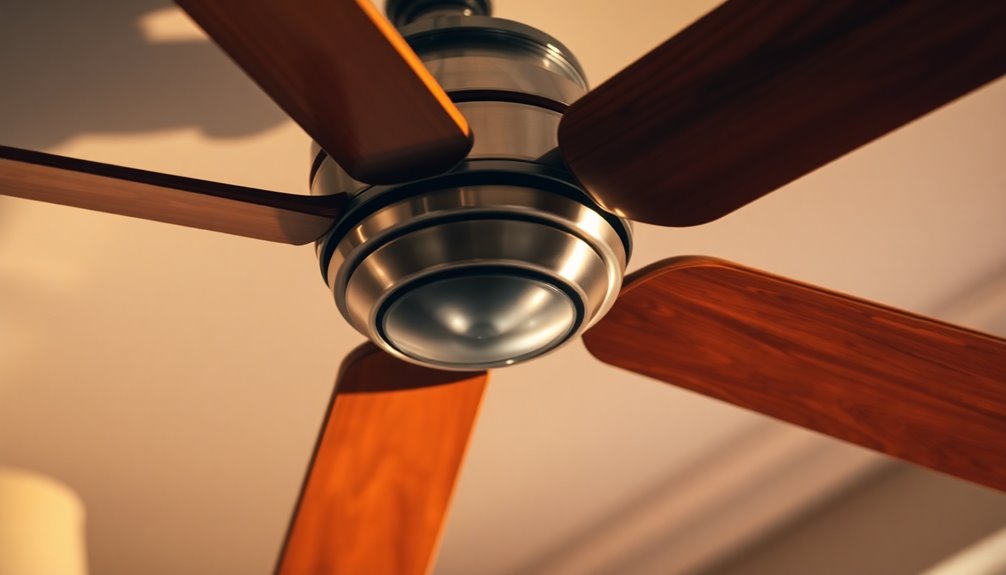
Understanding how your ceiling fan rotates is key to maximizing its benefits throughout the year.
You can set your fan to rotate counterclockwise in the summer, which pushes air down and creates a revitalizing breeze, helping you feel cooler and reducing reliance on air conditioning.
In winter, switch to clockwise rotation to pull air upwards, redistributing the warmer air near the ceiling back down into the room. This not only keeps your space cozy but also enhances your heating system's efficiency. Seasonal adjustments to the fan's direction can lead to significant energy savings and improved comfort levels.
By adjusting the fan's direction seasonally, you can save energy and potentially lower your thermostat settings, making your ceiling fan a cost-effective climate control solution.
Importance of Proper Use
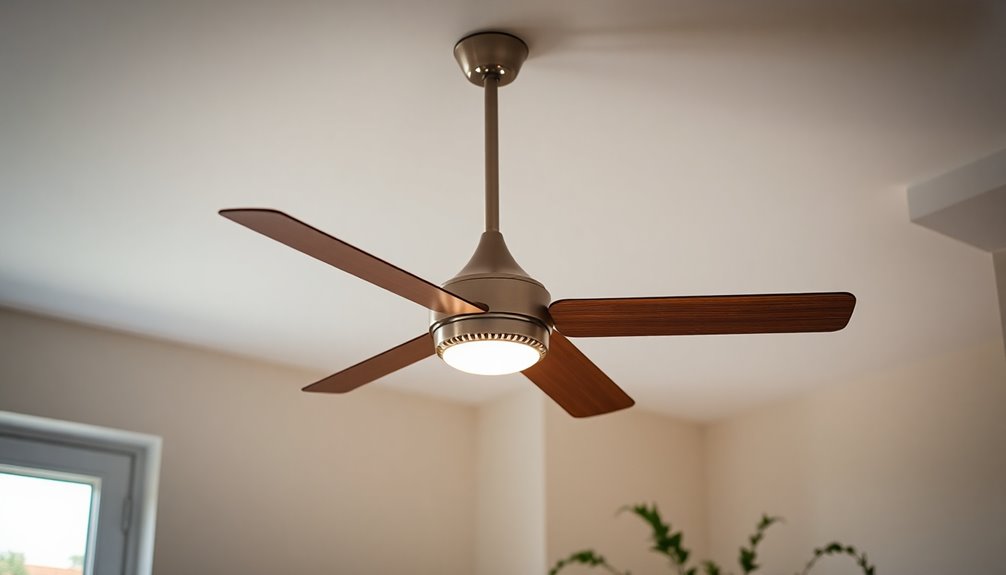
Proper use of your ceiling fan is essential for maximizing its benefits, as it can greatly enhance both comfort and energy efficiency in your home.
By reversing the fan direction in winter, you can save up to 10% on heating costs and reduce stress on your HVAC system. This simple adjustment helps distribute warm air evenly, making your space feel cozier. Additionally, using your fan allows you to set your air conditioner a few degrees higher, cutting down on energy consumption. This is a cost-effective solution for maintaining indoor warmth during the colder months. Furthermore, ceiling fans can be used in conjunction with heat pumps to further optimize heating efficiency.
Remember to clean the blades regularly and verify proper installation for peak performance.
With straightforward switches or remotes, adapting your fan for seasonal changes is easy, improving air circulation and overall comfort year-round.
Cool Facts About Fans
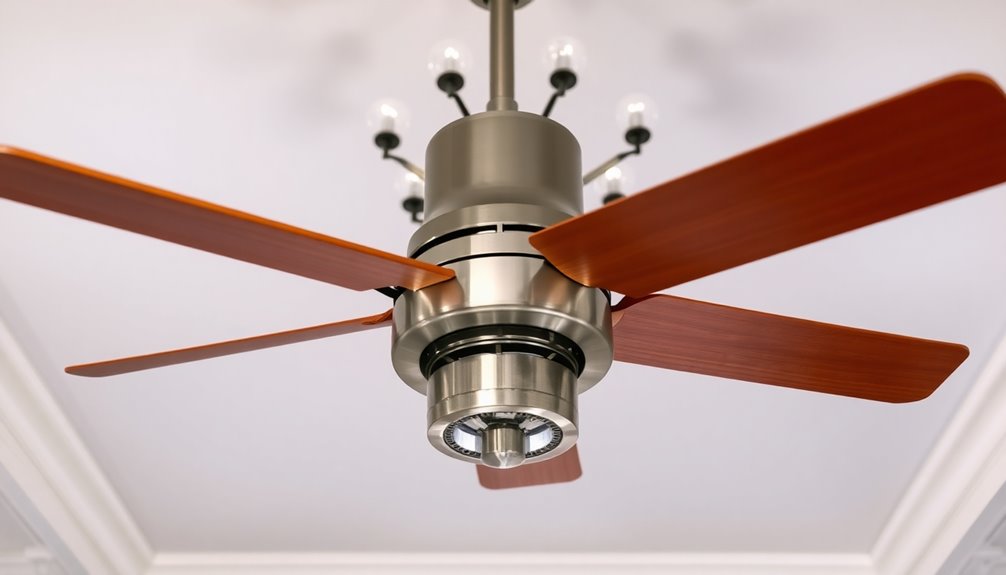
Ceiling fans are more than just decorative fixtures; they play an essential role in enhancing comfort and efficiency in your home.
You can easily control the direction of airflow to suit the seasons. In summer, running your fan counterclockwise creates a revitalizing breeze, while in winter, switching to clockwise pulls cool air up, pushing warm air down to keep your space cozy. This simple adjustment can greatly lower your energy bills by reducing reliance on your AC and heating systems. Additionally, ceiling fans promote even air circulation, helping to manage humidity and maintain a comfortable indoor climate. By optimizing warm air distribution, ceiling fans can significantly reduce heating costs during colder months. Furthermore, using energy-efficient models can enhance the overall effectiveness of your home's heating and cooling systems.
With modern fans often coming with remote controls, adjusting your fan's direction has never been easier.
Frequently Asked Questions
Can All Ceiling Fans Reverse Direction?
Not all ceiling fans can reverse direction, but many do have this feature.
Conventional fans typically include a switch near the pull cord, while modern ones often come with remote controls that include a reverse button.
It's essential to check your specific fan model to confirm if it has this function.
If it does, you can easily change the blade rotation for improved comfort and energy efficiency throughout the year.
How Do I Know if My Fan Is Reversible?
To know if your fan's reversible, start by locating the switch on the motor housing. It could be vertical or horizontal, indicating airflow direction.
If you have a remote, check for a button labeled for reversing the blades.
Inspect the motor housing for labels or arrows.
Finally, observe the airflow: if it changes direction when you flip the switch, your fan's reversible.
Older models might lack this feature, so check your fan's specifications too.
Is Reversing the Fan Necessary Every Season?
You might find reversing your ceiling fan necessary each season for ideal comfort.
In summer, set it to counterclockwise for an invigorating breeze.
In winter, switch it clockwise to distribute warmth evenly, reducing cold spots.
During fall and spring, it can help maintain even air circulation, though it's less critical.
Adapting your fan's direction guarantees efficient heating and cooling, ultimately saving energy and enhancing your home's comfort throughout the year.
What Is the Ideal Fan Speed for Winter Use?
For winter use, you'll want to set your ceiling fan to low speed. This helps redistribute warm air without creating drafts, keeping your space cozy.
You might even lower your thermostat a few degrees to save on heating costs while enjoying the warmth. If you have a larger room, medium speed can also work well.
Can Reversing the Fan Help With Allergies?
Reversing your ceiling fan can definitely help with allergies. By circulating air evenly, it reduces allergen concentration in specific areas.
When you push warm air down, it helps mix the air, distributing allergens more uniformly. Additionally, improved ventilation can aid in removing airborne allergens, creating a healthier environment.
Using the fan in winter can also decrease the buildup of allergens, making your space more comfortable and breathable.
Conclusion
To sum up, using the reverse function on your ceiling fan can greatly enhance your comfort year-round. By redistributing air, it helps you stay cool in summer and warm in winter, while also improving energy efficiency and humidity control. Remember to adjust your fan settings based on the season to maximize its benefits. Embracing this simple feature not only elevates your comfort but also contributes to a more enjoyable living environment. So, don't overlook the power of your ceiling fan!
